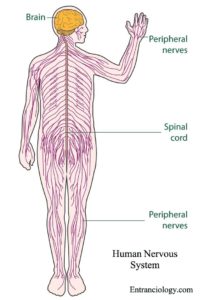The nervous system of the human body is composed of Neurons, Brain, Spinal Cord, Peripheral nerves, autonomic nerves. It is the network of nerve fibres and cells which transmits nerve impulses between different parts of the body.
Physiology and Anatomy of the Human Nervous System
Neurons are the basic structural and functional unit of the nervous system of human body. Neurons bundled together are known as nerves. The Neurons are composed of a cell body or cyton, a long cylindrical process called axon and terminal branches with knob like swellings at the ends. The cyton consists of the nucleus, nissl’s granules and a number of processes called dentrons branching into dendrites. The Axons consist of Schwann cells, and oligodendrocytes, and are enveloped by the myelin sheath that insulates the axon, which maintain rapid transfer of signals. The sheath is interrupted at intervals with small gaps called nodes of Ranvier. The terminal branches are placed very close to the dendrites of the next neuron, and the space in between is known as the synaptic cleft. The secretory vesicles of the synaptic knobs secrete chemicals called neurotransmitters, which may be epinephrine or acetylcholine.

The vertebrate nervous system of the human body is composed of the Brain, Spinal Cord and the peripheral nervous system and the autonomic nervous system. The brain consists of the forebrain ( prosencephalon ). The forebrain of the human body consists of the olfactory lobe, the cerebral hemisphere and diencephalon, consisting of the thalamus and hypothalamus. The midbrain of our body is composed of the cerebellum, pons varolli, and medulla oblongata. The brain is convered by meninges consisting of pia mater, arachnoid and the dura mater. The peripheral nervous system consists of motor or sensory neurons attached to the central nervous system of the body.
How the Process of Nervous System Works
The neurons receive stimuli, which pass down the axon and transmit the nerve impulses to the next neuron with the help of the neurotransmitters. When the nerve impulses reach the synaptic knob, they release acetylcholine in the synaptic cleft, which is taken up by the dendrites of the next neuron, transferring the impulses, and the process continues till it reaches to the brain. This is carried-out mainly by the sensory nerves. The brain sends the response via the motor nerves which helps in bringing about the reaction. The olfactory lobe of forebrain plays a role in the sense of the smell.
The cerebrum consists of two cerebral hemispheres, which are interconnected by corpus callosum. The cerebrum consists of 4 lobes helps in thinking and speech, the parietal lobe is related to sensations like touch, pain and temperature as well as taste. Smell is controlled by the occipital lobe. The thalamus is the centre for interpretation of sensory impulses. Hypothalamus (of the nervous system of the human body) controls involuntary functions like sleep, thirst, fatigue etc. It also secrets neuro-hormone or releasing factors, and controls the pituitary gland.
The optic lobe controls the auditory stimuli, and cerebral peduncles act as coordination centers between the forbrain, and the hindbrain. The Cerebellum and The Pons of the hindbrain coordinate muscular activity; the medulla oblongata controls heart beats, breathing and blood vessel diameter and coordinates reflexes like swallowing and vomiting. The peripheral nervous system controls voluntary muscle control whereas the autonomic nervous system controls the voluntary muscle control in the human body.


